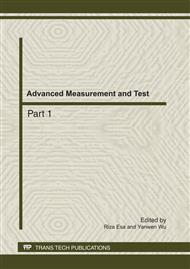[1]
Otero, M., et al., (2010). Thermogravimetric analysis of biowastes during combustion., Waste Management 30(7): 1183-1187.
DOI: 10.1016/j.wasman.2009.12.010
Google Scholar
[2]
Wainwright, P.J., Cresswell, D.J.F., (2001). Synthetic aggregate from combustion ashes using an innovative rotary kiln., Waste Managemet 21: 241–246.
DOI: 10.1016/s0956-053x(00)00096-9
Google Scholar
[3]
Nie Qi hong, Sun Shao zeng, Li Zheng qi., et al., (2001). Thermogravimetric analysis on the combustion characteristics of brown coal blends., Journal of Combustion Science and Technology 7(1): 71-76.
Google Scholar
[4]
Hu Rong zu., (2008). Thermal analysis kinetics., Beijing: Science Press.
Google Scholar
[5]
Huang Chuan, Jing Huang., et al., (2010). Application of formula uniform design for manufacture of haydite with sewage sludge., Chinese Journal of Environmental Engineering 4(4): 919-925.
Google Scholar
[6]
Huang Chuan, Xueyan Yao., et al., (2010). Analysis of batch formula and optimizing calcination conditions of light-weight aggregates prepared by municipal solid waste., Journal of Chongqing University 33(5): 139-144.
Google Scholar
[7]
Chiou, I., K. Wang, et al. (2006). Lightweight aggregate made from sewage sludge and incinerated ash., Waste Management 26(12): 1453-1461.
DOI: 10.1016/j.wasman.2005.11.024
Google Scholar
[8]
Folgueras, M. B., R. M. Diaz, et al. (2003). Thermogravimetric analysis of the co-combustion of coal and sewage sludge., Fuel 82(15-17): 2051-(2055).
DOI: 10.1016/s0016-2361(03)00161-3
Google Scholar
[9]
Otero, M., L. F. Calvo, et al. (2008). Co-combustion of different sewage sludge and coal: A non-isothermal thermogravimetric kinetic analysis., Bioresource Technology 99(14): 6311-6319.
DOI: 10.1016/j.biortech.2007.12.011
Google Scholar
[10]
Wang, X., Y. Jin, et al. (2009). Development of lightweight aggregate from dry sewage sludge and coal ash., Waste Management 29(4): 1330-1335.
DOI: 10.1016/j.wasman.2008.09.006
Google Scholar
[11]
Xiao, H. -m., X. -q. Ma, et al. (2009). Isoconversional kinetic analysis of co-combustion of sewage sludge with straw and coal., Applied Energy 86(9): 1741-1745.
DOI: 10.1016/j.apenergy.2008.11.016
Google Scholar
[12]
Xiao, H. and K. Liu (2010). Co-combustion kinetics of sewage sludge with coal and coal gangue under different atmospheres., Energy Conversion and Management 51(10): 1976-(1980).
DOI: 10.1016/j.enconman.2010.02.030
Google Scholar
[13]
He Bi fan, Li-ao Wang, Huang Chuan, et al. (2010). Study on Combustion Characteristics and Kinetics of Chongqing Municipal Sewage Sludge., Proceedings of the CSEE, 37(35): 32-37.
Google Scholar
[14]
Hu Qin hai, Yun-long Xiong, et al. (2008). Study on combustion kinetics of coal water slurry prepared with sewage sludge., Acta Scientiae Circumstantiae, 19(06): 1149-1154.
Google Scholar
[15]
Liao Yan fen, Xiao-qian Ma. (2009). Combustion behavior and kinetic characteristics of a city sewage sludge., Journal of Fuel Chemistry and Technology, 37(03): 296-301.
Google Scholar
[16]
Jing-yong Liu, Shui-yu Sun, et al. (2010). Experimental study on combustion characteristics and its kinetics of paper mill sludge., Chinese Journal of Environmental Engineering, 4(03): 693-699.
Google Scholar
[17]
Wan Jia yu, Yu-qi Jin, et al. (2010). Study on Combustion Characteristics and Kinetics of Municipal Sludge Under Different Oxygen Concentrations., Proceedings of the CSEE, 34(05): 35-40.
Google Scholar
[18]
Wang Yu ming, Jian-hong Hu, et al. (2007). Experimental Study on Combustion and Kinetic Characteristics of Mixed Industrial Sludge., Proceedings of the CSEE, 9(17): 44-50.
Google Scholar
[19]
Xu Guo ren, Jin-long Zhou, et al. (2007). Utilization of dried sludge as an additive for making ceramsite., Journal of Harbin Institute of Technology, 11(04): 557-560.
Google Scholar


